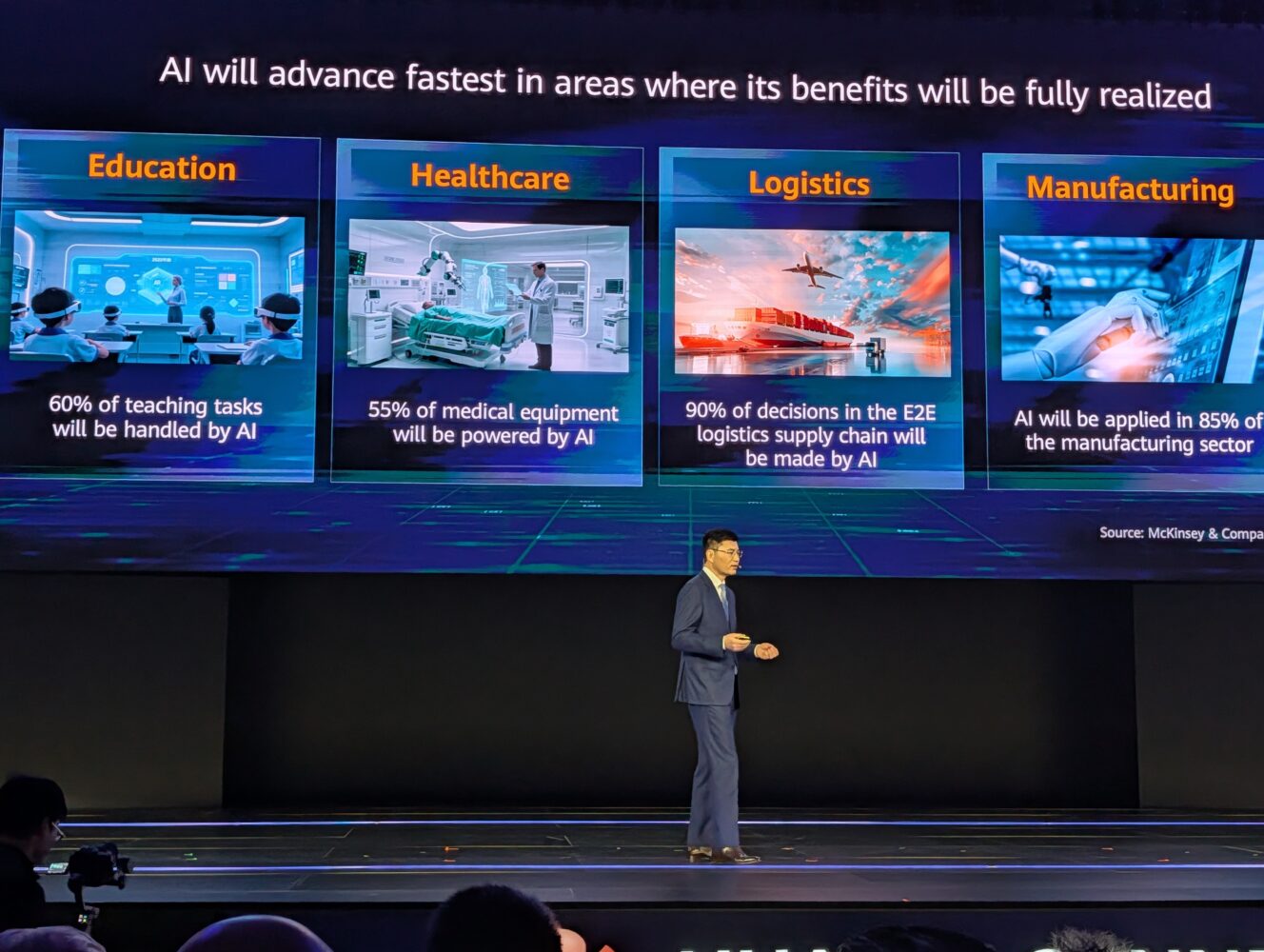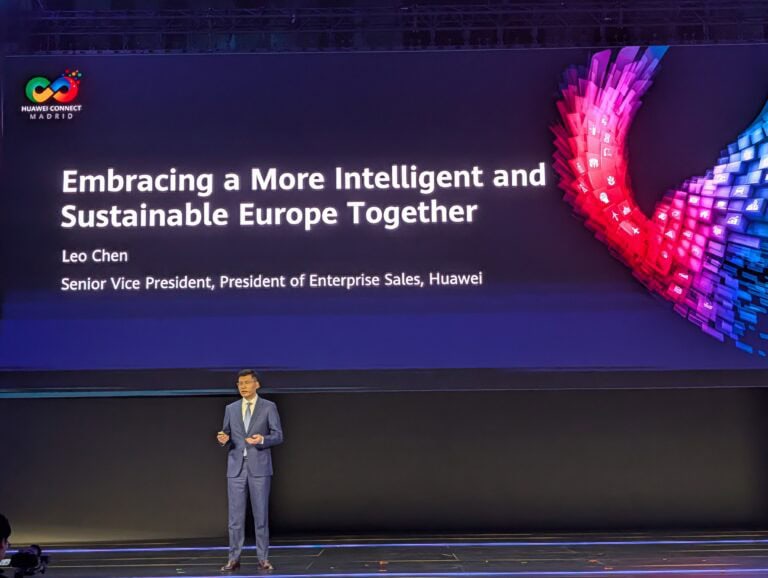Huawei is ramping up efforts to support and accelerate the technological ambitions of European companies. Whether SME or enterprise, the goals are often built around intelligence and sustainability. During our visit to this week’s Huawei Connect Madrid, we discovered the ambitious plans to tackle AI adoption and sustainability challenges. Targeted solutions for SMEs, industry-specific innovations, and expanded partner programs are part of the strategy.
According to Huawei, AI adoption in our region is still at an early stage, and many small- and mid-sized businesses have yet to reach a mature level of digital readiness. The continent also faces a significant shortage of skilled IT professionals, with Senior Vice President and President of Enterprise Sales Leo Chen claiming we require over 8 million new specialists to meet 2030 targets. It’s posing a major challenge to meeting the long-term digital ambitions.
The gaps represent significant obstacles as businesses worldwide increasingly rely on cutting-edge technology to gain a competitive advantage. Huawei aims to address these challenges through three strategic pillars: technology innovation, partner ecosystem development, and talent development.
The company has established what it calls OpenLabs in Paris and Istanbul, where experts from different verticals identify future digital needs and develop industry-specific solutions. At those locations, it collaborated with over 150 local partners to develop industry-specific solutions based on real-world scenarios.
AI benefits already visible across sectors
When looking at how the verticalisation turns out, Huawei believes that AI will advance most in areas where the benefits will be fully realised: education, healthcare, logistics, and manufacturing. In education, for example, online learning platforms powered by AI assistants are making quality resources more accessible and helping students customize their learning journeys.
Healthcare providers are, in turn, using telemedicine (telecommunication technology to provide and support healthcare services) to reach patients regardless of location. Meanwhile, logistics companies are leveraging AI for demand forecasting, procurement management, and transportation optimization, with over 90 percent of supply chain decisions soon to be made automatically.
Lastly, manufacturing operations are implementing flexible production lines with AI-driven efficiency improvements. Industrial AI is making concepts like one-person factories a reality, Leo Chen claims, while AI helps tailor products and shopping experiences to individual needs.

SME solutions take center stage
Small and medium enterprises face unique hurdles in the intelligence shift. Many lack sufficient in-house expertise or resources to develop custom AI solutions. Huawei sees a need for simplified, pre-integrated options that enable faster service deployment and quicker problem resolution.
This is where the Huawei eKit 4+10+N Intelligent Solution for SMEs comes in. It focuses on four common scenarios: intelligent office, intelligent business, intelligent education, and intelligent healthcare. “This solution focuses on SMEs’ four most common scenarios”, Leo Chen explained. These scenarios account for roughly half of the daily activities and almost all SME operations.
The approach includes 10 specific solutions that address challenges ranging from customer acquisition costs to user experience personalization. The package includes networking products such as the CloudEngine S series switches, AR Wi-Fi routers, and intelligent conferencing equipment. All components come pre-integrated and pre-validated, simplifying deployment for distribution partners.
The system supports technologies in networking, security, and business information systems, enabling SMEs to adopt digital more easily and rapidly. Being cost-effective is what Huawei hopes will be a main driver in accelerating adoption further.
Distribution partner system gets overhaul
Huawei also depends on its partner approach to make the story in Europe a success. On this front, it has recently revamped its distribution partner system to close three major gaps: solution development, sales enablement, and delivery services.
For solution development, the company offers pre-integrated and pre-validated products, making it easier for distribution partners to customize solutions. Sales enablement includes a one-stop portal with resources like solution guides and scenario-based configuration tools. Delivery services cover unified installation, network management, and customer support, reducing the need for multiple site visits.
So-called Gold Distribution Partners now have access to the full product portfolio. They get the gold status for their expertise in distribution, support, training, and marketing. Senetic from the UK is an example of such a mature partner. Huawei plans to increase the numbers on this front, with goals of over 50 gold distribution partners and 1,000 Value Added Resellers across Europe by next year.
Industry-specific innovations expand
Beyond SME solutions, Huawei unveiled multiple industry-focused offerings. The medical technology solutions improve AI-powered diagnostic accuracy. Smart retail solutions optimize store operations through converged Wi-Fi 7 and IoT platforms. Smart hotel solutions enhance service quality and safety measures. Managed network services enable integrated cloud-edge management, while intelligent manufacturing solutions boost R&D efficiency.
Huawei’s flagship enterprise products demonstrate significant technical advances. The latest all-flash storage delivers 99.9999% system reliability, which is according to Huawei ten times the industry standard. The architecture supports seamless online upgrades without requiring data migration. One healthcare customer reduced data recovery time from weeks to hours using the system, Leo Chen explains.
For connectivity, Huawei provides 50G PON fiber-to-the-office solutions delivering five times the bandwidth of standard options. Wi-Fi 7 access points integrate IoT capabilities and deliver 10 Gbps network performance.
Talent development accelerates
As mentioned at the start of this article, Huawei also has talent shortages on its radar. That’s why it’s expanding its ICT Academy, Joint Lab, and Certification programs. The company aims to train 50,000 new ICT professionals by 2030, and will do so through several initiatives. Earlier it launched its Seeds for the future program, for example, which also trained some Dutch starters on the job market.
The Huawei ICT Academy provides online courses, teaching materials, and certification programs for universities, having already supported over 600 teachers and 30,000 students. This year, 15 European teams reached the global finals of the ICT competition, including representatives from Germany, Spain, Italy, and Poland.
For partner enablement, Huawei offers more than 200 courses on technologies like AI and storage. The courses have generated over 4,600 enrollments. The company trains over 1,600 partner engineers annually and has awarded over 7,600 professional certifications. By 2030, Huawei plans to train an additional 1,000 partner engineers.
Huawei’s multi-pronged approach addresses Europe’s digital challenges through technology innovation, ecosystem development, and skills training. Whether these initiatives can close the continent’s digital gaps remains to be seen, but the company is clearly positioning itself as a key player in Europe’s technological future.
Also read: Huawei focuses on AI and green transition in Europe
